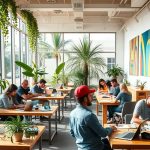You’ve likely noticed how the shift to remote work has changed your city’s vibe. With fewer people commuting, downtown areas are seeing a drop in foot traffic, which impacts local businesses heavily. As urban planners rethink these spaces, new opportunities arise for revitalization and community engagement. But what does this mean for the future of our cities and the way we interact with them? The answer might surprise you.
Table of Contents
Key Takeaways
- Remote work preferences shift urban design towards mixed-use developments, emphasizing residential spaces and amenities for remote workers.
- Local businesses suffer from reduced foot traffic, leading to lower sales and potential closures in downtown areas.
- Public transportation and infrastructure are being re-evaluated due to decreased commuter numbers, enhancing accessibility for residents.
- Urban revitalization efforts, like pop-up markets and co-working spaces, aim to strengthen community ties and economic resilience.
- Future commercial real estate trends focus on flexible, adaptable spaces that cater to hybrid work environments and foster collaboration.
The Shift to Remote Work: Trends and Statistics
As remote work becomes more mainstream, you’ll find that its impact on urban economies is significant. Many companies are embracing flexible work arrangements, leading to a noticeable shift in employment patterns.
Statistics show that over 70% of workers now prefer a hybrid model, blending remote and in-office days. This trend has prompted urban planners to rethink the use of office space; many are converting traditional workplaces into mixed-use developments.
You’ll also notice a decrease in daily commuters, reducing traffic congestion and pollution. Millennials and Gen Z are driving this shift, valuing work-life balance over proximity to the office.
Consequently, urban areas are evolving, prioritizing residential spaces and amenities that cater to a more remote workforce, reflecting changing preferences in where you choose to live and work.
Effects on Local Businesses and Retail
As remote work continues to shape our daily lives, you might notice a decline in foot traffic at local businesses.
With more people shopping online, retailers are feeling the pinch and adjusting their strategies.
This shift also puts pressure on the service industry, as fewer customers mean less demand for their offerings.
Decline in Foot Traffic
While many employees appreciate the flexibility of remote work, local businesses and retailers are grappling with a significant decline in foot traffic. This reduction has serious implications for their survival and growth.
As you might notice, fewer people in downtown areas means:
- Decreased Sales: Local shops and cafes rely on daily commuters and office workers for revenue.
- Business Closures: Many establishments struggle to stay afloat, leading to empty storefronts and lost jobs.
- Reduced Community Engagement: With fewer visitors, local events and markets see diminished participation, weakening community ties.
- Real Estate Challenges: Property owners face declining demand for retail space, impacting rental income and property values.
These effects create a ripple, changing the urban landscape and challenging the vibrancy of your community.
Shift to E-Commerce
The rise of e-commerce has transformed the retail landscape, presenting both challenges and opportunities for local businesses. As more shoppers turn to online platforms, you might find that traditional brick-and-mortar stores struggle to maintain foot traffic and sales.
This shift means you need to adapt your strategies—whether it’s enhancing your online presence or offering unique in-store experiences that can’t be replicated online. However, e-commerce also opens doors for you to reach a broader customer base without geographical limitations.
Impact on Service Industry
Remote work has markedly reshaped the service industry, affecting local businesses and retail in ways that are both profound and complex.
As you navigate this new landscape, you’ll notice several key impacts:
- Reduced Foot Traffic: With fewer people commuting, local cafes and shops struggle to attract customers.
- Shifted Demand: Some services, like home delivery and online shopping, have surged, while others, such as office supply stores, face declines.
- Adaptation Strategies: Businesses are pivoting to enhance online presence, offering curbside pickup and expanding delivery options.
- Community Connection: Local businesses are emphasizing their role in the community, fostering loyalty through personalized services and engagement.
These changes challenge you to rethink how you support and engage with local businesses during this evolving era.
Changes in Urban Infrastructure and Transportation
As more workers embrace remote positions, cities are rethinking their infrastructure and transportation systems to adapt to these new realities. You may notice changes in public transit schedules and road usage patterns as commuters decrease. Cities are reallocating resources to enhance biking and walking paths, making urban areas more livable.
| Change | Impact |
|---|---|
| Reduced traffic congestion | Quieter streets |
| Increased bike lanes | Healthier lifestyles |
| Enhanced public spaces | Community engagement |
| Revamped public transit | Better accessibility |
These adjustments aim to create a more sustainable urban environment, reflecting a shift in how you and your neighbors live and work. Embracing these changes, cities can foster a sense of community even in a remote work era.
Opportunities for Urban Revitalization
As remote work reshapes how you view urban spaces, you might notice exciting opportunities for revitalization.
Creative space utilization can transform vacant buildings into vibrant hubs, while local businesses could thrive with increased foot traffic.
Mixed-use developments also hold potential to create dynamic communities that cater to both work and leisure.
Creative Space Utilization
While many cities grapple with the challenges posed by declining foot traffic and changing consumer behaviors, creative space utilization offers a promising avenue for revitalization.
By reimagining vacant spaces, you can spark innovation and community engagement. Here are some strategies worth exploring:
- Pop-up Markets: Transform empty storefronts into vibrant markets for local artisans and food vendors, attracting foot traffic and fostering community ties.
- Co-working Spaces: Convert underutilized buildings into collaborative workspaces, catering to remote workers seeking a sense of community.
- Art Installations: Use vacant lots for temporary art exhibits, enhancing the cultural landscape and drawing visitors.
- Community Gardens: Turn neglected areas into green spaces, promoting sustainability and providing a gathering spot for residents.
Embracing these ideas can breathe new life into urban environments.
Local Business Growth
Revitalizing urban areas isn’t just about reimagining vacant spaces; it’s also about nurturing local businesses that can thrive in these environments. As remote work reshapes how people engage with their neighborhoods, you’ll find unique opportunities for local entrepreneurs. Embracing a community-centric approach can generate foot traffic and foster connections among residents.
| Opportunity | Potential Impact |
|---|---|
| Pop-up shops | Increase local visibility |
| Farmers markets | Boost community engagement |
| Artisan workshops | Encourage skill sharing |
Mixed-Use Development Potential
Mixed-use developments present a unique opportunity to breathe new life into urban areas by blending residential, commercial, and recreational spaces.
These projects can revitalize downtown cores, making them more vibrant and sustainable. Here are some key benefits you can expect:
- Increased Foot Traffic: By combining different functions, you create a lively environment that attracts residents and visitors alike.
- Economic Diversification: Mix of businesses supports local economies and reduces dependency on single industries.
- Community Engagement: Shared spaces foster social interaction, enhancing community ties and improving quality of life.
- Sustainable Living: Proximity to amenities encourages walking and reduces reliance on cars, promoting a healthier lifestyle.
Embracing mixed-use development can transform urban landscapes and create thriving communities.
Rethinking Commercial Real Estate
As remote work reshapes how businesses operate, you might find that the commercial real estate landscape is undergoing a significant transformation. With more employees working from home, companies are reconsidering their need for large office spaces. Flexibility has become key, and landlords are adapting by offering shorter leases and reimagining spaces.
Here’s a quick look at the evolving priorities in commercial real estate:
| Feature | Traditional Offices | Remote-Ready Spaces | Co-Working Areas |
|---|---|---|---|
| Lease Length | Long-term | Flexible | Short-term |
| Design Focus | Standard Layouts | Collaborative Areas | Shared Amenities |
| Tenant Needs | High Capacity | Hybrid Work Models | Networking Potential |
These changes signal a shift toward more adaptive, flexible environments in response to evolving workforce needs.
The Future of Urban Planning in a Remote Work Era
The rise of remote work isn’t just reshaping commercial real estate; it’s also prompting a fundamental rethink of urban planning.
The shift towards remote work is redefining urban landscapes and challenging traditional planning concepts.
As you navigate this evolving landscape, consider how these key elements might influence future urban designs:
- Mixed-Use Developments: Integrating residential, commercial, and recreational spaces fosters vibrant communities.
- Green Spaces: Prioritizing parks and outdoor areas enhances well-being and attracts residents.
- Flexible Infrastructure: Designing adaptable workspaces can accommodate the shifting needs of remote workers.
- Public Transport Accessibility: Improving transit options guarantees connectivity and supports sustainable commuting.
Frequently Asked Questions
How Has Remote Work Affected Urban Property Values?
Remote work’s changed how you view urban property values. With fewer people needing office space, demand’s shifted. You’re likely noticing lower prices in some areas while others adapt, creating diverse opportunities for investment and living.
What Are the Environmental Impacts of Decreased Commuting?
Decreased commuting cuts down on carbon emissions, improving air quality. You’ll notice less traffic congestion and noise pollution. As a result, urban environments become healthier, promoting biodiversity and enhancing overall quality of life in your area.
How Do Remote Workers Influence Local Culture and Community?
Remote workers enrich local culture by participating in community events, supporting small businesses, and sharing diverse perspectives. You’ll find they foster connections, inspire creativity, and contribute to a vibrant atmosphere that benefits everyone.
What Role Does Technology Play in Facilitating Remote Work?
Technology streamlines your remote work experience, connecting you with colleagues and resources instantly. Tools like video conferencing, project management software, and cloud storage empower you to collaborate effectively, ensuring productivity no matter where you are.
Are There Specific Industries Thriving Due to Remote Work Trends?
Yes, you’re seeing industries like tech, customer service, and marketing thrive because of remote work. These sectors benefit from flexibility, tapping into wider talent pools and reducing overhead costs, which boosts their overall productivity and growth.




